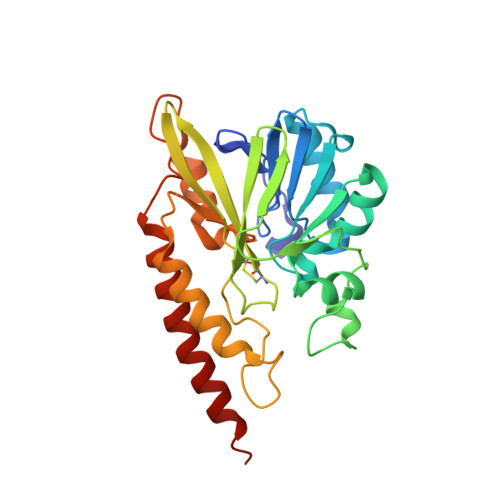High-resolution crystal structure of the subclass B3 metallo-beta-lactamase BJP-1: rational basis for substrate specificity and interaction with sulfonamides.
Docquier, J.D., Benvenuti, M., Calderone, V., Stoczko, M., Menciassi, N., Rossolini, G.M., Mangani, S.(2010) Antimicrob Agents Chemother 54: 4343-4351
- PubMed: 20696874
- DOI: https://doi.org/10.1128/AAC.00409-10
- Primary Citation of Related Structures:
3LVZ, 5WCM - PubMed Abstract:
Metallo-β-lactamases (MBLs) are important enzymatic factors in resistance to β-lactam antibiotics that show important structural and functional heterogeneity. BJP-1 is a subclass B3 MBL determinant produced by Bradyrhizobium japonicum that exhibits interesting properties. BJP-1, like CAU-1 of Caulobacter vibrioides, overall poorly recognizes β-lactam substrates and shows an unusual substrate profile compared to other MBLs. In order to understand the structural basis of these properties, the crystal structure of BJP-1 was obtained at 1.4-Å resolution. This revealed significant differences in the conformation and locations of the active-site loops, determining a rather narrow active site and the presence of a unique N-terminal helix bearing Phe-31, whose side chain binds in the active site and represents an obstacle for β-lactam substrate binding. In order to probe the potential of sulfonamides (known to inhibit various zinc-dependent enzymes) to bind in the active sites of MBLs, the structure of BJP-1 in complex with 4-nitrobenzenesulfonamide was also obtained (at 1.33-A resolution), thereby revealing the mode of interaction of these molecules in MBLs. Interestingly, sulfonamide binding resulted in the displacement of the side chain of Phe-31 from its hydrophobic binding pocket, where the benzene ring of the molecule is now found. These data further highlight the structural diversity shown by MBLs but also provide interesting insights in the structure-function relationships of these enzymes. More importantly, we provided the first structural observation of MBL interaction with sulfonamides, which might represent an interesting scaffold for the design of MBL inhibitors.
Organizational Affiliation:
Dipartimento di Biologia Molecolare, Laboratorio di Fisiologia e Biotecnologia dei Microrganismi, Università di Siena, I-53100 Siena, Italy.
















